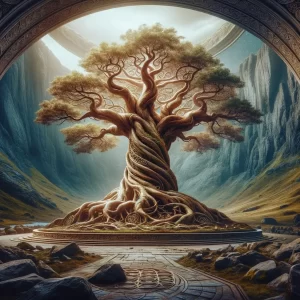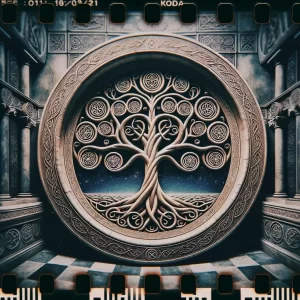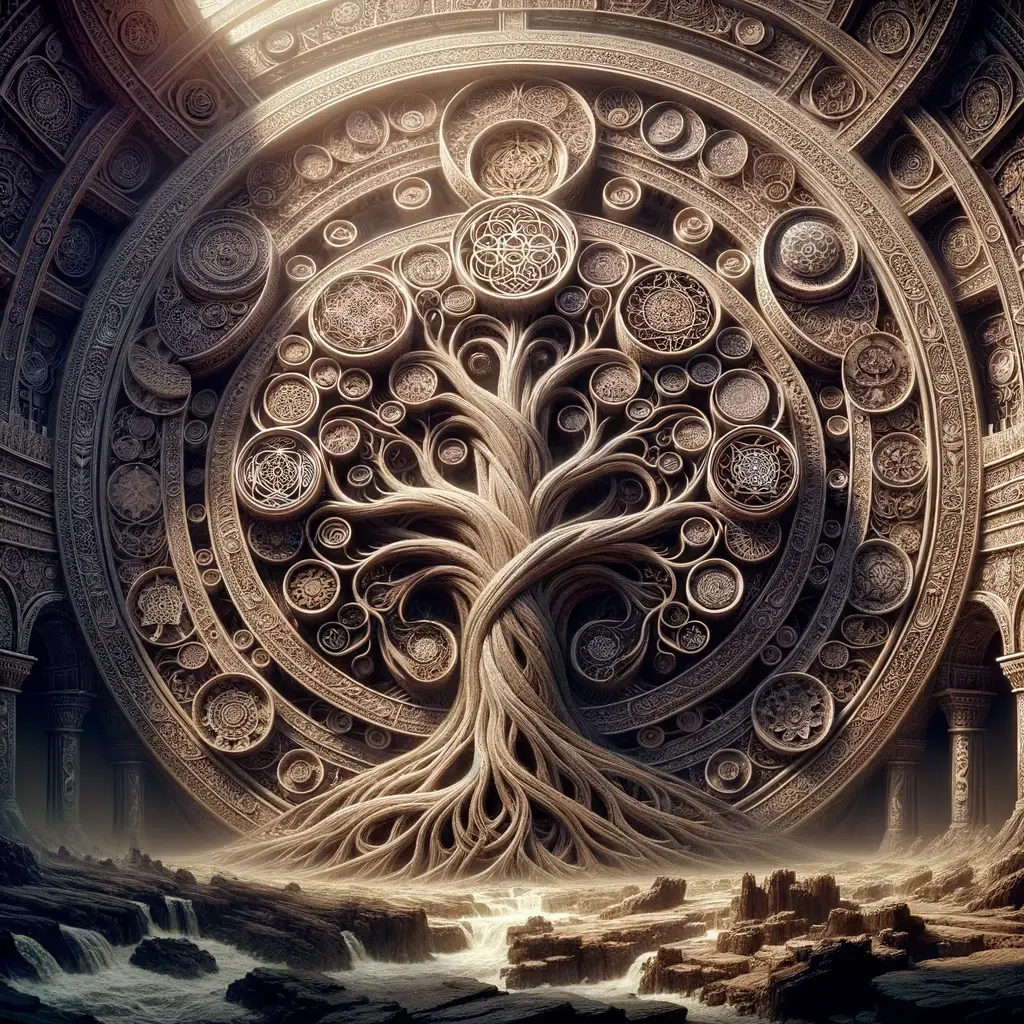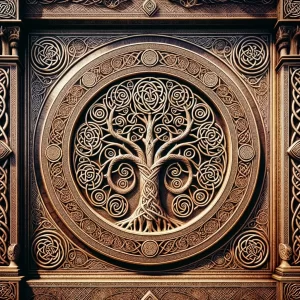The Celtic Tree of Life is an ancient symbol that has been used for centuries by the Celtic people. It is also sometimes referred to as the Irish Tree of Life.
It is a powerful representation of the interconnectedness of all living things. The Celtic Tree of Life symbol is often depicted as a tree with branches reaching towards the sky and roots that extend deep into the earth.
The Celtic Tree of Life meaning is deeply spiritual for the Celts. It is believed to represent the cycle of life, death, and rebirth. The tree’s branches are said to symbolize the different paths that one can take in life, while the roots represent the unseen forces that keep everything connected.
The Tree of Life symbolism is also associated with a number of other Celtic symbols, such as the triskele and the spiral. These symbols are often used together to represent the cyclical nature of life and the interconnectedness of all things. Despite its ancient origins, the Tree of Life remains a powerful symbol that continues to resonate with people today.

Origins of the Celtic Tree of Life
The Celtic Tree of Life is an ancient symbol that has been used by the Celts for centuries. It is a symbol of the interconnectedness of all things in the universe and represents the cycle of life, death, and rebirth. The tree is seen as a powerful symbol of growth, strength, and stability.
The origins of the Celtic Tree of Life are shrouded in mystery, but it is believed to have its roots in ancient Celtic mythology. The Celts believed that trees were sacred and had magical properties. They saw trees as a link between the physical and spiritual worlds and believed that they could communicate with the spirits of the trees.
The Celtic Tree of Life is often depicted as a tree with branches reaching up to the heavens and roots reaching down into the earth. The branches of the tree represent the different paths that people can take in life, while the roots represent the connection between the physical and spiritual worlds.
The Celts also believed that each tree had its own unique properties and that different trees were associated with different aspects of life. For example, the oak tree was associated with strength and endurance, while the willow tree was associated with healing and intuition.
Symbolism of the Celtic Tree of Life
The Celtic Tree of Life is a symbol that represents the connection between all living things. It is often depicted as a tree with branches reaching towards the sky and roots extending deep into the earth. This symbol has been used by the Celts for centuries and continues to be an important part of their culture today.
Connection to Nature
The Celtic Tree of Life is a symbol of the connection between humans and nature. The branches of the tree represent the sky and the heavens, while the roots represent the earth and the underworld. The tree is a reminder that all living things are connected and that we must respect and protect the natural world.
Symbol of Harmony and Balance
The Celtic Tree of Life is also a symbol of harmony and balance. The tree is rooted in the earth, but its branches reach towards the sky. This represents the balance between the physical and spiritual worlds. The tree is a reminder that we must strive for balance and harmony in our own lives.
Representation of Rebirth
The Celtic Tree of Life is also a symbol of rebirth. The tree sheds its leaves in the fall and grows new ones in the spring. This represents the cycle of life, death, and rebirth. The tree is a reminder that even in the darkest of times, new life can emerge.

Usage in Celtic Art
In Ancient Celtic Art
The Celtic Tree of Life has been a popular motif in ancient Celtic art. It was often depicted as a large tree with branches reaching towards the sky and roots reaching into the earth. The tree was seen as a symbol of the interconnectedness of all things in the world. The Celts believed that the tree represented the cycle of life, death, and rebirth, and that it was a powerful symbol of renewal and regeneration.
The Tree of Life was often used in Celtic art to decorate everyday objects such as jewelry, pottery, and weapons. It was also used in more elaborate works of art such as illuminated manuscripts, where it was often used to mark the beginning or end of a section.
In Modern Celtic Art
The Tree of Life continues to be a popular motif in modern Celtic art. It is often used in jewelry, clothing, and home decor. The design of the tree has evolved over time, with artists incorporating their own unique style and interpretation.
In modern Celtic art, the Tree of Life is often depicted in a more abstract form. The tree may be simplified to a few branches or may be combined with other Celtic symbols such as knots or spirals. The design may also incorporate different colors or textures to create a more contemporary look.

Interpretation in Celtic Mythology
Tree Worship
In Celtic mythology, trees were highly revered and considered sacred. The Celts believed that trees were the source of life and held great spiritual power. They worshipped trees and believed that they were inhabited by spirits or deities. The Celtic Tree of Life, also known as the Crann Bethadh, was a symbol of the interconnectedness of all living things and the cycle of life, death, and rebirth.
Sacred Trees in Celtic Lore
The Celts had a deep respect for certain trees, which they believed had special properties and were associated with specific deities. Here are some examples:
- Oak: The oak tree was associated with the god Dagda, who was considered the father of the gods. The oak was also a symbol of strength, endurance, and wisdom.
- Ash: The ash tree was associated with the goddess Nemhain, who was considered the goddess of war and battle. The ash was also a symbol of protection and healing.
- Holly: The holly tree was associated with the god Lugh, who was considered the god of light and music. The holly was also a symbol of protection and fertility.
- Yew: The yew tree was associated with the goddess Hecate, who was considered the goddess of death and rebirth. The yew was also a symbol of transformation and renewal.
The Celts believed that by connecting with these sacred trees, they could gain access to the wisdom and power of the deities associated with them. They also believed that trees had the ability to communicate with each other and with humans, and that they could provide guidance and healing.
Celtic Tree of Life in Tattoo Art
The Celtic Tree of Life is a popular symbol in tattoo art. It is a representation of the interconnectedness of all living things, and it is often depicted as a tree with branches and roots that reach out to the sky and the earth. The tree is a powerful symbol of growth, strength, and stability, and it is often used to represent the cycle of life and death.
Many people choose to get a Celtic Tree of Life tattoo because of its deep spiritual meaning. The tattoo can be a reminder of the importance of staying grounded and connected to nature, and it can also serve as a symbol of personal growth and transformation.
There are many different ways to incorporate the Celtic Tree of Life into a tattoo design. Some people choose to get a small, simple tattoo of the tree on their wrist or ankle, while others opt for a larger, more intricate design that covers their entire back or chest.
In addition to the tree itself, many Celtic Tree of Life tattoos also include other symbols and elements that are meaningful to the wearer. These can include animals, such as birds or wolves, or other Celtic symbols like knots or spirals.
Celtic Tree of Life – FAQ’s
What is the meaning of Celtic Tree of Life?
The Celtic Tree of Life represents the interconnectedness of all living things. It is a symbol of the cycle of life, death, and rebirth. The tree’s branches signify the various paths one can take in life, while its roots symbolize the unseen forces that keep everything connected. It stands as a reminder of the balance between the physical and spiritual worlds and emphasizes growth, strength, and stability.
How is the Celtic Tree of Life symbol used in Celtic art?
The Celtic Tree of Life has been a popular motif in ancient Celtic art, decorating everyday objects like jewelry, pottery, and weapons. In modern times, the symbol continues to be used in jewelry, clothing, and home decor, often with contemporary interpretations and designs that may incorporate other Celtic symbols or use varied colors and textures.
What do the different parts of the tree represent?
The branches of the Celtic Tree of Life symbolize the different paths that individuals can take in life and the sky or heavens. In contrast, the roots represent the connection between the physical and spiritual worlds, the earth, and the underworld. The tree as a whole stands as a symbol of growth, strength, and stability.
How is the Celtic Tree of Life interpreted in Celtic mythology?
In Celtic mythology, trees were considered sacred and believed to hold spiritual power. The Celtic Tree of Life, also known as the Crann Bethadh, symbolized the interconnectedness of all living things and the cycle of life, death, and rebirth. Certain trees were revered and associated with specific deities and attributes, such as the oak with strength and endurance and the ash with protection and healing.
Why is the Celtic Tree of Life a popular tattoo design?
The Celtic Tree of Life is a popular tattoo motif because of its deep spiritual meaning, representing the interconnectedness of all living things, personal growth, and transformation. Whether in a small, simple design or a larger, intricate one, the symbol serves as a reminder of the importance of staying grounded, connected to nature, and the continuous cycle of life and death.
What is the Celtic tree of life in Gaelic?
In Gaelic, the Celtic Tree of Life is referred to as “Crann Bethadh.”
Is the Tree of Life an Irish thing?
The Tree of Life is a symbol that has been found in various cultures worldwide. In the context of the Celts, which includes the Irish, it holds significant meaning and is sometimes referred to as the Irish Tree of Life. So, while it is not exclusively Irish, it is a symbol that has been embraced and given particular significance in Irish culture and spirituality.
What is a Tree in Celtic culture?
In Celtic culture, trees were revered and considered sacred. They believed trees held great spiritual power and served as links between the physical and spiritual worlds. Trees were thought to be inhabited by spirits or deities, and they played essential roles in rituals and ceremonies. Different trees were associated with specific attributes and deities, like the oak symbolizing strength and endurance. Trees were not only physical entities but were also seen as living beings with wisdom and spiritual essence.
To learn more about the importance of Trees in Celtic mythology, check out this great video below:


